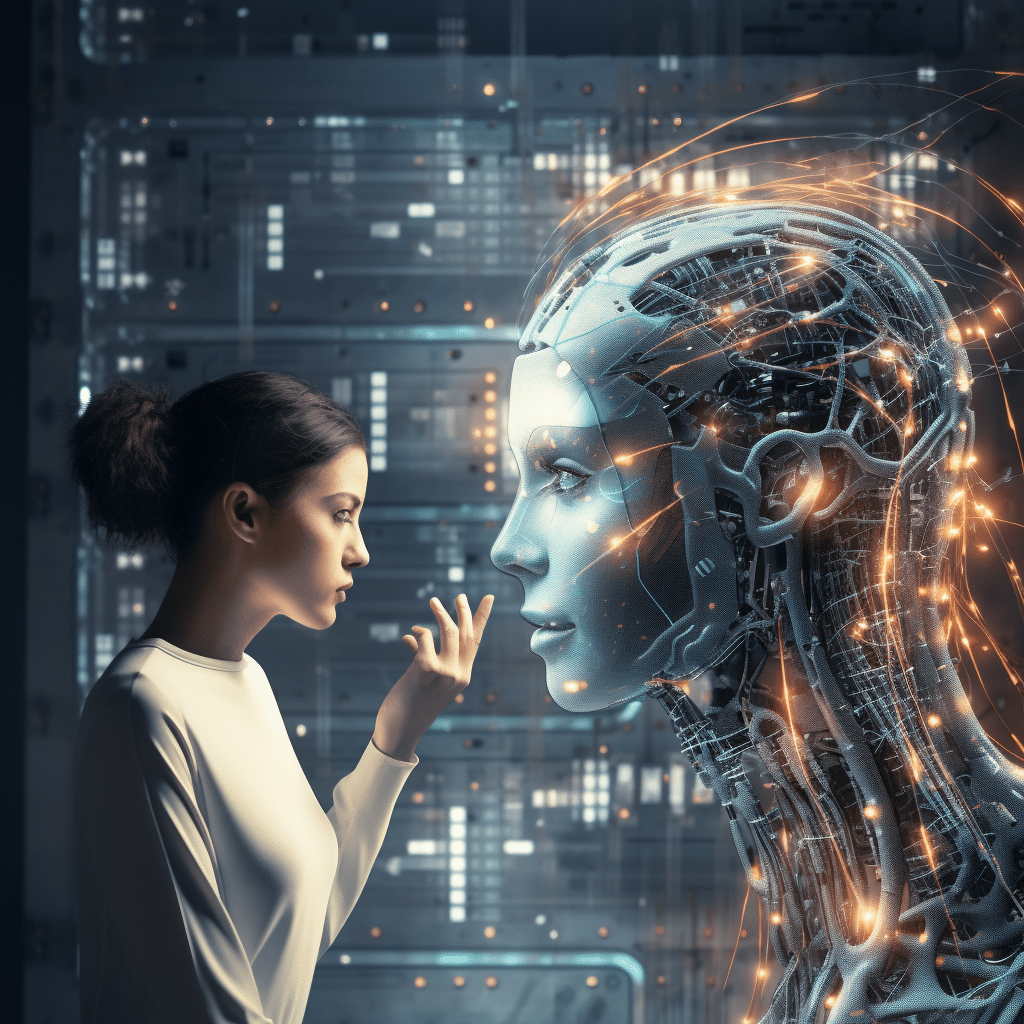
The Psychological Impact of AI in the Workplace

Introduction
Psychological Impact of AI in the Workplace, As artificial intelligence (AI) continues to make its way into various industries, the workplace environment undergoes significant transformation.
While AI brings numerous benefits to businesses, its introduction also poses several psychological implications for employees.
Understanding these impacts is crucial to ensure a healthy and productive work environment.
1. Fear of Job Loss
AI’s ability to automate tasks that were previously performed by humans often instills fear of job loss among employees.
The fear of being replaced by machines can lead to heightened stress, anxiety, and decreased job satisfaction.
Recognizing and addressing these concerns through open communication and retraining programs can alleviate these psychological burdens.
2. Shift in Work Responsibilities
With the integration of AI, employees often experience a shift in their work responsibilities.
Some tasks become automated, allowing workers to focus on more complex and creative endeavors.
While this can enhance job satisfaction, it may also cause stress as employees adapt to new roles and acquire additional skills.
Offering appropriate training and support during this transition empowers employees to embrace their evolving roles.
3. Trust and Dependence on AI
Employees’ trust in AI systems profoundly impacts their acceptance and utilization.
Initially, employees may feel hesitant to rely on AI suggestions or decision-making algorithms.
However, as AI consistently demonstrates reliability and competence, the workforce gradually develops trust in these systems.
Overcoming the resistance by providing clear explanations, ensuring transparency, and maintaining human oversight fosters trust and acceptance of AI solutions.
4. Ethical Concerns
Ethical concerns related to AI in the workplace can affect employees’ psychological well-being.
Issues such as data privacy, algorithmic bias, and misuse of AI capabilities may create psychological distress and a sense of mistrust.
Organizations should prioritize ethical practices, establish robust policies, and regularly educate employees about the responsible use of AI.
5. Collaboration with AI
Collaborating with AI tools and systems can positively influence employee productivity and job satisfaction.
Employees who perceive AI as a helpful tool rather than a threat are more likely to embrace this collaboration.
Encouraging a culture that supports AI integration, offering training on AI utilization, and celebrating successful collaborations contribute to a positive psychological impact.
Conclusion
As AI becomes more prevalent in the workplace, organizations must prioritize understanding the psychological impact on employees.
By addressing concerns related to job security, work responsibilities, trust, ethics, and collaboration, companies can foster a positive and inclusive environment where humans and AI work hand in hand towards collective success.
What are the specific psychological challenges that employees may face when working alongside AI systems, such as dealing with job displacement or the fear of being replaced?
Psychological Impact of AI in the Workplace, Working alongside AI systems can bring about various psychological challenges for employees. Some of these challenges include:
1. Job displacement:
One of the main concerns employees may face is the fear of being replaced by AI systems. The fear of job loss can lead to increased stress, anxiety, and insecurity about future employment prospects.
2. Loss of professional identity:
Employees may have developed a strong sense of identity and pride in their profession. With the introduction of AI systems, they might experience a loss of belonging and purpose, as their traditional tasks and responsibilities may be taken over by automation.
3. Skill obsolescence:
Employees may worry about their skills becoming obsolete in the face of advancing AI technology. This can result in a fear of being left behind professionally and struggling to keep up with the changing job market requirements.
4. Reduced job satisfaction:
AI systems often automate repetitive or mundane tasks, leaving employees with less engaging work. This shift can lead to decreased job satisfaction and feelings of monotony, as employees may no longer find their work challenging or meaningful.
5. Increased pressure to perform:
Some employees may feel the need to constantly prove their value and demonstrate their abilities to justify their place in the workforce alongside AI systems. This pressure to outperform machines can lead to burnout and heightened levels of stress.
6. Ethical concerns:
Employees may feel conflicted about the ethical implications of AI systems, especially if they are involved in the development or implementation of such technology. This can result in moral distress and potential internal conflict between personal values and job responsibilities.
Addressing these psychological challenges requires employers to prioritize employee well-being and facilitate a smooth transition to working alongside AI systems. Providing retraining opportunities, promoting open communication about job changes, and involving employees in the decision-making process can help alleviate some of these concerns.
How does the growing presence of AI in the workplace affect employees’ mental well-being and overall job satisfaction?
Psychological Impact of AI in the Workplace, The growing presence of AI in the workplace can have both positive and negative effects on employees’ mental well-being and overall job satisfaction. On one hand, AI can automate repetitive and mundane tasks, freeing up employees’ time and allowing them to focus on more meaningful and challenging work. This can lead to higher job satisfaction as employees feel more engaged and fulfilled in their roles.
Additionally, AI can provide valuable insights and support decision-making processes, leading to increased efficiency and productivity. This can reduce work-related stress and contribute to employees’ mental well-being.
On the other hand, the introduction of AI can create concerns and anxiety among employees about job security and the potential replacement of certain tasks or roles by machines. This fear of job loss or the need to acquire new skills to adapt to AI technology can lead to increased stress, job dissatisfaction, and a decline in mental well-being.
Moreover, the reliance on AI in certain tasks may reduce social interaction and human connection in the workplace. This can negatively impact employees’ mental well-being, as social interaction and positive relationships with colleagues are often important factors contributing to job satisfaction.
In summary, the impact of AI on employees’ mental well-being and overall job satisfaction depends on various factors such as the nature of tasks being automated, the level of support provided by organizations during AI implementation, and the overall work environment. It is crucial for organizations to consider these factors and proactively address any potential negative consequences to ensure employees’ well-being and job satisfaction are maintained or enhanced.
How can organizations proactively address and mitigate potential negative psychological impacts of AI in the workplace to ensure a healthy and resilient workforce

Psychological Impact of AI in the Workplace, AI technologies are becoming increasingly prevalent in the workplace, but their implementation can potentially lead to negative psychological impacts on employees. Organizations must take proactive measures to address and mitigate these impacts to ensure a healthy and resilient workforce. Here are some strategies they can adopt:
1. Employee Involvement:
Involve employees in the decision-making process and implementation of AI systems. This includes seeking their input, listening to their concerns, and addressing any fears or uncertainties they may have regarding AI technologies.
2. Training and Upskilling:
Provide comprehensive training programs to educate employees about AI and its implications. This will empower them to understand the technology and its potential benefits, reducing anxiety and resistance.
3. Transparent Communication:
Maintain open and transparent communication channels with employees. Clearly communicate the objectives of AI implementation, its limitations, and how it will impact their work. This helps to manage expectations and build trust.
4. Skill Redeployment:
Emphasize the need for reskilling and upskilling to adapt to changing job roles and responsibilities. This will assure employees that their value is recognized and that AI technologies are not intended to replace them, but rather enhance their capabilities.
5. Work-Life Balance:
AI technologies can contribute to an “always-on” work culture. Encourage employees to establish boundaries and maintain a healthy work-life balance. Establish policies and practices that promote well-being, such as flexible working hours and clear guidelines on after-work communication.
6. Emotional Support:
Provide access to resources and support systems that address the potential psychological impacts of AI. This can include dedicated counseling services, employee assistance programs, or workshops focused on dealing with stress and anxiety.
7. Ethical Guidelines:
Develop and enforce ethical guidelines for AI use in the workplace that prioritize employee well-being. Ensure that AI systems are designed to respect privacy, are transparent, and make fair and unbiased decisions.
8. Ongoing Monitoring:
Continuously monitor the impact of AI technologies on the workforce. Collect feedback from employees, conduct regular surveys, or establish focus groups to identify and address any emerging negative psychological impacts promptly.
9. Continuous Learning Culture:
Foster a culture of continuous learning by encouraging employees to constantly update their skills and knowledge. This can help them embrace AI as a tool for growth and development rather than viewing it as a threat.
10. Employee Advocacy:
Encourage employees to share their experiences and feedback on the psychological impact of AI implementation. This can help identify areas of improvement and create a platform for open dialogue between management and employees.
By implementing these strategies, organizations can address and mitigate potential negative psychological impacts of AI in the workplace, fostering a healthy and resilient workforce.









Thank you for your sharing. I am worried that I lack creative ideas. It is your article that makes me full of hope. Thank you. But, I have a question, can you help me?
Your point of view caught my eye and was very interesting. Thanks. I have a question for you.